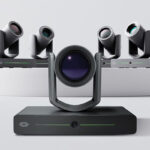The AV industry is swiftly moving to the cloud, but closed systems are still slowing progress. With each manufacturer, software vendor and service provider building their own proprietary environments, true integration remains elusive. MSPs find themselves managing fragmented platforms and frustrated customers, trapped in a cycle of compatibility issues and costly workarounds.
Open APIs offer a path forward by enabling different AV systems to seamlessly communicate, allowing MSPs and in-house AV/IT teams to integrate preferred tools, streamline operations, and improve service delivery. In this article, we’ll explore why open APIs are foundational for the AV industry and the strategic advantages for MSPs and their customers that embrace this open, connected approach.
The Interoperability Challenge in AV Cloud Adoption
Despite the shift to cloud-based AV, most systems still operate in silos. Each manufacturer and software provider builds proprietary platforms that do not communicate with each other. This creates serious challenges for MSPs, who must manage multiple systems with little integration. The result is wasted time, increased costs and frustrated customers.
Without a better approach, MSPs will continue to spend more time troubleshooting than optimizing the customer experience. Open APIs provide a path forward by enabling different AV systems to communicate openly and through a shared framework, reducing inefficiencies and improving service delivery.
Real-World Use Cases
Open APIs give MSPs the flexibility to create smarter, more efficient AV solutions without the burden of managing inconsistent, proprietary integrations. By enabling seamless communication across platforms, they unlock new capabilities that improve service quality and operational efficiency. Here’s how:
- Cloud-Based AV Monitoring: MSPs can pull real-time data from displays, projectors and other AV devices into a single dashboard, regardless of the manufacturer. This data stream enables proactive maintenance, which reduces downtime and service disruptions by enabling technicians to address issues remotely before they affect users.
- Automated Room Booking: Open APIs allow meeting room systems to integrate directly with device health data across different brands. If a display or conferencing system is offline, the room booking system can automatically detect the issue and reroute users to a functional space. This ensures a smooth meeting experience without last-minute technical troubleshooting.
- Dynamic Digital Signage: Open APIs enable digital signage platforms to draw data from occupancy sensors and AV systems in real time, no matter the manufacturer. This allows businesses to deliver targeted messaging, such as promotions when foot traffic is high or directions to alternative meeting areas when a space reaches capacity, without manual updates.
- Cloud-Based Automation: MSPs can seamlessly integrate AV systems with cloud-based automation tools, without the need for vendor-specific workarounds. A room’s lighting, audio levels and display settings can adjust dynamically based on occupancy or predefined triggers, which improves user experience across different devices and platforms.
By breaking down integration barriers, open APIs do more than streamline operations — they create business opportunities. Far beyond operational benefits, open APIs drive long-term competitive advantage in an evolving AV market.
Business Impact and Future of Open APIs in AV
In a highly competitive marketspace, MSPs are actively seeking solutions that reduce complexity, lower costs and improve service quality. Open APIs achieve all these goals by eliminating the need for custom integrations with every new platform or device.
Standardized connections allow MSPs to deploy systems faster, simplify troubleshooting and offer more flexible service options. Instead of working within rigid, vendor-specific ecosystems, MSPs can leverage open APIs to integrate best-in-class tools. This offers customers more choices and better performance — a whole new level of flexibility that positions MSPs as strategic technology partners rather than just service providers.
But open APIs are more than a competitive advantage today — they are the building blocks of AV’s future. As the industry moves toward greater automation and intelligence-driven operations, open APIs will be the foundation for next-generation AV ecosystems. The demand for them will only grow as AV systems become more cloud-driven and interconnected.
The Bottom Line
The AV industry must move beyond closed ecosystems. MSPs need open APIs first and foremost to simplify integration, lower costs, and improve service quality. A shared API structure would streamline connections, enabling seamless communication between devices, platforms, and software — unlocking the full potential of open APIs. Open APIs are not just a convenience — they form the foundation of a more connected, efficient and future-ready AV industry.
Omer Brookstein is CEO and co-founder, Xyte.










